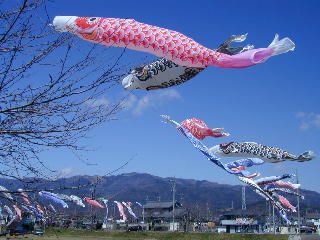Tango no Sekku is celebrated on May 5th. In Japan, this day is called Boys’ Festival. It’s been celebrated for over a millennium. Originally it was celebrated in the houses of warriors. It celebrated boys’ courage and determination. Many of the symbols of this day are about having the character of a warrior. Eventually this day became important to all households in Japan with boys.
After WWII, Boys’ Day became toned down. This holiday officially became known as Children’s Day or Kodomo no hi. It’s supposed to be a day to celebrate the health and happiness of all children. But many people still see it as Boys’ Festival.
Large carp windsocks, called koinobori, are displayed outside houses of families with boys. There’s one windsock for each boy in the house. The largest windsock is for the oldest son of the house.
The carp is a symbol of Tango no Sekku, because carp are considered strong and determined. They’re able to swim upstream against the flow of the water. This is a day for families to celebrate their sons’ strength and character.
Warrior dolls and helmets, armor and swords are also displayed in houses with boys.
The symbolic flower of Tango no Sekku is a type of iris called shobu. The shobu has long leaves that resemble swords. Boys traditionally take shobu leaf baths on this day. The shobu is so important on this day that sometimes the festival is called Shobu no Sekku or Iris Festival.
One traditional food eaten on this day is kashiwa mochi. It’s a rice cake steamed with sweet beans and wrapped in an oak leaf. Another traditional food is chimaki, which is rice wrapped in bamboo leaves.
Here’s a traditional song for Tango no Sekku called Koinoburi or Carp Windsocks…
Koinobori
(Japanese Transliteration)Yane yori takai koinobori.
Okii magoi wa otoosan.
Chisai higoi wa kodomotachi.
Omoshiro soni oyideru.Carp Windsocks
(English)Carp windsocks are above the roof.
The biggest carp is the father,
The smaller carp are children,
They’re enjoying swimming in the sky.
I welcome any midis or mp3’s of Koinobori, the Japanese text and also any comments about the traditions of this day.
Come visit the Mama Lisa’s World Japan Page for more Songs from Japan!
This article was posted on Wednesday, May 3rd, 2006 at 4:14 pm and is filed under Children's Day, Countries & Cultures, Holidays Around the World, Japan, Japanese, Japanese Kids Songs, Kodomo no hi - Japanese Children's Day, Koinobori, Koinobori - Carp Windsocks, Languages, Shobu no Sekku or Iris Festival, Tango no Sekku - Japanese Boys' Festival, Tango no Sekku - Japanese Boys' Festival Songs. You can follow any responses to this entry through the RSS 2.0 feed. You can skip to the end and leave a response. Pinging is currently not allowed.
13 Responses to “The Japanese Boys’ Festival called “Tango no Sekku”, plus a Song for the Holiday called “Koinobori””
Leave a Reply


























May 5th, 2006 at 7:40 am
[…] I learned a lot about this festival from Mama Lisa’s World Blog, and I found a link to the Koinobori song there. Here it is – (Original MP3 site) […]
August 29th, 2006 at 3:38 am
Hey,
I am doing a Japanese Public Holiday powerpoint presentation for school
and we need to have a song for each public holiday can you please email me a link to the website where you found the Koinobori song please.
I will be needing it in the next week, it’s urgent. So please email it to me.
My email address is above.
Thanks heaps,
Anonymous
December 2nd, 2008 at 3:45 pm
this is great!
February 4th, 2010 at 12:20 pm
[…] MP3 of Koinobori You can read more about Tango no Sekku […]
May 2nd, 2014 at 11:36 am
[…] May 5, Kodomo no Hi (子供の日): Children’s Day in Japan. The festival was originally called Tango no Sekku (Boys’ Day) until several decades ago, when it was renamed Kodomo no Hi to celebrate the happiness […]
May 2nd, 2014 at 12:11 pm
[…] May 5, Kodomo no Hi (子供の日): Children’s Day in Japan. The festival was originally called Tango no Sekku (Boys’ Day) until several decades ago, when it was renamed Kodomo no Hi to celebrate the happiness […]
July 26th, 2014 at 6:30 am
[…] ancient Chinese custom where the royal guards wore ceremonial helmets and carried bows and arrows. Tango-No-Sekku used to be celebrated on the 5th day of the 5th moon of the Lunar or Chinese calendar but the date […]
August 23rd, 2014 at 8:14 am
[…] means carp streamer, are carp-shaped windsocks that are traditionally flown in commemoration of the Tango no Sekku in Japan (national children’s day). In this traditional event, these windsocks are made in the honor for a […]
October 22nd, 2014 at 1:15 am
[…] The words “Musha Ningyo” literally meant “warrior dolls” when they are translated. More often than not, these are the dolls referred to be in use during the Boy’s Day Festival that is celebrated every fifth of May in Japan. […]
May 2nd, 2015 at 3:52 am
Thank you for the information on Boys’ Day. We have several grandsons and nephews.
September 21st, 2016 at 11:09 pm
I have a collection of these warrior dolls that has been in my family around the turn of the century. Most of my family have since past and haven’t explained about these dolls. I would like to know more.
i tried clicking on your site but no site. Can you help?
Thanks doug
September 22nd, 2016 at 1:07 pm
Hi Doug, If you can email me some pics, I can ask a Japanese friend about them for you. -Lisa
January 22nd, 2022 at 7:05 am
When I was a Junior in high school in 1967 we had a Creative Writing class assignment to write a haiku poem. I wrote the following:
The day of the Boys
Colorful kites in the wind
Old grandfathers eyes smile
This was published in Haiku Highlights publication the summer I turned eighteen. I did not know such a festival existed.